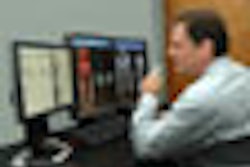A teleradiology practice has developed a software application that automatically integrates patient and exam information transmitted by fax directly into a folder of DICOM patient images. The software application eliminates the clerical time associated with document scanning of paper-based information and significantly reduces the potential risk of mismatched records.
The application, called DICOM Fax Adder, was the brainchild of Dr. Allen Rothpearl of Complete Radiology Reading Services, a teleradiology practice headquartered in Westbury, NY. Rothpearl described the concept in a paper published online on October 31 in the Journal of Digital Imaging.
Rothpearl's practice needed a reliable and consistent means to obtain patient demographic and referring physician information, as well as technologists' notes, from referring physicians. The process needed to be inexpensive, fast, and easy for the firm's clients to provide, and not be labor-intensive for the practice. For a solution, the practice turned to the concept of software identification of faxes containing patient identification bar codes.
"The key concept in our development of the DICOM Fax Adder was the realization that we had to send some type of returnable information to the client site where the patient examination originates from before the clinical paperwork is sent back to us," Rothpearl said. "The returnable information had to be keyed to the examination that had originated from the facility."
The group initially considered document scanners, but a number of the practice's clients didn't own them. What they all did own was a fax machine.
The software is designed on the premise that when an exam arrives on a teleradiology system's DICOM server, it requests the location that transmitted the exam for patient and exam information. It consists of two applications: DICOMQuery and AutoSend.
DICOMQuery continuously monitors the teleradiology system's DICOM server. When a new exam is detected on the server, DICOMQuery stores the DICOM header information from the study in a database for later retrieval by the second application, AutoSend.
A PDF file containing the name of the patient, exam, and body part of the exam is created and submitted to a fax server, which transmits this to the originating client in the form of a bar-coded cover sheet. The front desk staff of the client site is requested to match the cover sheet with the patient's paperwork, and transmit all of this promptly back by fax.
This information, received as a multipage TIFF file, reaches a preassigned internal e-mail address on the radiology practice's e-mail server. Processing by the AutoSend command includes verification that all the paperwork is in an immediately readable format. Papers faxed upside down, sideways, or tilted are automatically rotated.
This information is converted into a DICOM format and sent to the DICOM server, inserted as the first series of the patient's DICOM image folder. At this point, the patient's file transfers to a worklist for interpretation. If the contents of a fax are unintelligible, an alert is generated, and another fax request containing the bar code cover sheet will be sent to the client.
The software also generates and autofaxes a daily log to each client that contains the patient names and exams sent to the teleradiology practice over the past 24 hours, and which also indicates if the paperwork requested by fax was received.
"Our clients review the patient exam log as soon as they receive it and notify us promptly if there are discrepancies," Rothpearl told AuntMinnie.com. "Because the process is so easy, the clients comply and we are able to immediately have clinical information available that we need to assist remote radiologists, including a referring physician's contact information if there are urgent findings to report. This software tool enables us to provide better service to our clients. Its behind-the-scenes functionality is a godsend to daily operations of our practice."
Additional details about the software are posted at www.medimagingtools.com, and Rothpearl will also be presenting a poster session at the RSNA annual meeting.
By Cynthia Keen
AuntMinnie.com staff writer
November 12, 2008
Related Reading
Software boosts delivery of critical results, July 17, 2008Copyright © 2008 AuntMinnie.com



















